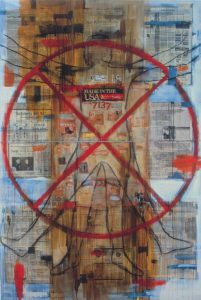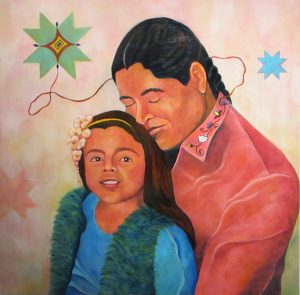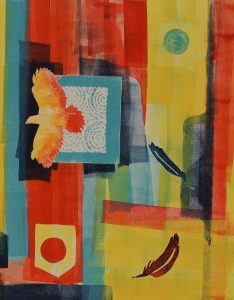Dakota Hoska is an art history graduate student and took our summer course, “What is Native American Art,” taught by Dr. Jill Ahlberg Yohe, Assistant Curator of Native American Art at the Minneapolis Institute of Art. Dakota was also a recipient of our Native American Art History Fellowship, made possible with support from the University of St. Thomas College of Arts and Sciences Dean’s Office.
What drew you to the study of Native American art through a graduate art history course—both personally and professionally?
As a Native person, the image that comes to mind when I reflect upon my cultural existence is that of a large Jenga tower, with many structural components missing. I feel the voids, the emptiness left by those missing pieces. One by one I’m trying to recreate those pieces and slide them back into my tower, knowing I’ll stand stronger if I can reclaim them.
All of my studies, my artwork, my job and my personal energy go into rebuilding what was lost and what was taken. Courses like the Native American Art History class offered by St. Thomas are building blocks, helping to replace those same missing pieces.
Unfortunately, my story is not unique. Many Native Americans are missing large parts of their cultural history—including information related to their artistic heritage, because many of their artistic endeavors were closely tied to their traditions and practices. Those traditions and life ways were attacked on multiple fronts. The stated goal was to obliterate a Native person’s cultural identity and to assimilate them into the culture of the conqueror.
- Takúuŋkičhiyapi: wakháŋyeža owás thewíčhuŋȟiŋdapi (We are all related: We all love our Children), Dakota Hoska, 2016, Oil on Panel, 36” X 36, Recently shown in the “Reframe Minnesota” show
- Dakota Hoska on Left and Šišókaduta on right; Šišókaduta and his daughter Phoebe are the subjects of this painting
This class and others like it are important on a personal and professional level for Native students like myself, but also for Non-native students. They help to build appreciation and equanimity for the beautifully rich cultural and artistic histories of Native Americans, while schooling Euro-Americans on alternative modalities and motivations for making. Additionally, they bring awareness to beautiful works of historic art that were almost lost, while showcasing progressive Native artists who rely on a broad array of influences—traditional, European, political, familial—to produce works unlike others known in the Western canon.
What research project did you pursue and why do you think this research is important?
For my research project, I chose to delve into the career of one of the most prolific, political and popular Native American Art figures of our time—Jaune Quick-to-See Smith. I was interested in her because within the artistic world, she was hit with a double “handicap”: She is Native and she’s a woman.

The Red Mean, Jaune Quick-to-See Smith, Salish and Kootenai Tribes of the Flathead Indian Nation, 1992, Acrylic, Newspaper collage, Shellac and Mixed Media on Canvas, 90 X 60 in., Smith College Museum of Art
I was inspired by Jaune’s steady commitment to her artistic calling as well as to her Native community. I learned a great deal in my research about Jaune’s choice to continually engage her audience in important dialogues around the issues of being Native, of being a woman in a male-centric field, and of being a committed environmentalist. I came to respect her deeply as a person of great strength and character, who continually chose her path, when others tried to tell her she had no choice.
Because of the research I completed on this artist, I was able to advocate for greater representation of her artwork in an upcoming exhibition I am assisting with. (I work as a research assistant at the Minneapolis Institute of Art.) I have also been inspired, within my own artistic process, to utilize more printmaking and collage in my work. Finally, throughout her career Jaune never forgot her ties to her community. The struggle between the Western world and our own cultural heritage is real and Native artists deal with this struggle in a spectrum of ways, from creating work that is completely culturally embedded to striving for only Western recognition in their careers. I respect the balance Jaune found on that spectrum.
3) How will this course continue to have an impact on you moving forward?
For me, this course will be one of the most important I will take at St. Thomas as I strive to focus my Art History studies on Native American Art History. I wish I had many more courses along these lines to choose from. Unfortunately, these classes can be few and far between in all institutions of higher learning, which gives me an even deeper appreciation for the importance of this class. I’m always thankful when I find something that so directly relates to my future aspirations.


